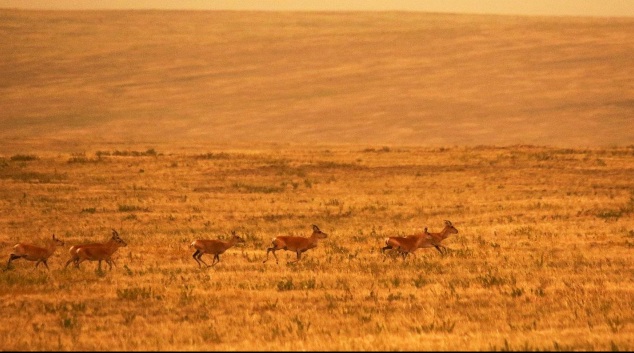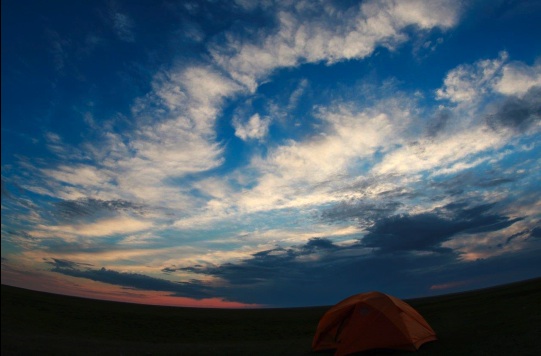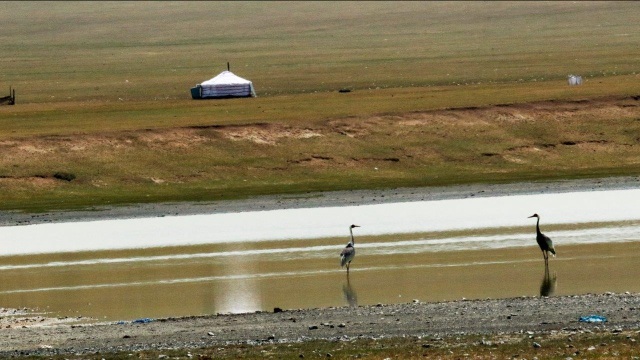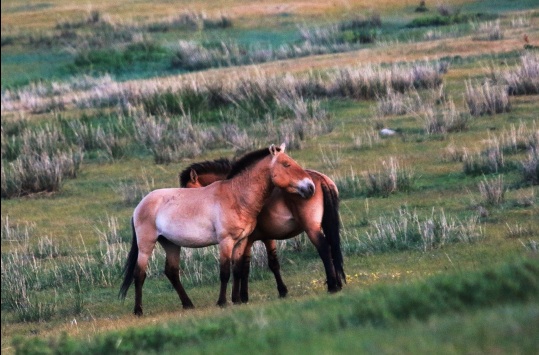What's it like to go on a Travel Adventure sponsored by the Angeles Chapter? Leader Bruce Hale shares this account of the amazing adventure in Mongolia he co-led with Leader Fred Dong. Check out all of our Travel Adventure trips to plan your next dream vacation. The leaders are planning another trip to Mongolia for 2018. The upcoming adventure will focus on the Gobi Desert and the northwest region of Mongolia, the region of alpine lakes and eagle-hunters. It will be about two weeks long and will include three nights of yent camping as well as some ger camping. Stay tuned for details.
Twenty-three intrepid participants enjoyed an extraordinary travel adventure upon the steppes and grasslands of Mongolia on a two-week trip sponsored by the Angeles Chapter in June. Once we got outside of the capital Ulaanbaatar (frequently called UB, we rode upon bumpy dirt roads in a caravan of four-wheel-drive vans (plus a cook van and equipment truck) over mile after mile of vast, wide-open spaces.
 |
| Gazelles running fast in the distance at Toson Hulstay Preserve. Photos by Nelson Hsu of Redwood City, Calif. |
I found it exhilarating to be, as it were, “right in the middle of nowhere.” The grasslands and steppes have a special beauty of their own. In June, the grasses are green, carpeting the flatlands as well as the rolling hills. But the grasses and other flora are stunted, growing very close to the ground, from the two-year drought in Mongolia. The sage plants, also stunted and ever so close to the ground, still exude their fresh herbal fragrance. Sunsets and sunrises, cloud formations, and starry night skies tend to be gorgeous upon the steppes.
But summers here are short; by the end of August, the cold of winter already starts to set in. In terms of farming, much of the produce raised in Mongolia has to be grown in greenhouses.
 |
| Sunset at camp, as seen through fisheye lens. |
Tour operator Mongolia Trekking, provided us with excellent service. The cook crew prepared gourmet style meals from scratch in places so remote there are no stores or restaurants around the corner. The crew had a big square tent for their kitchen and another for our dining room. Often the crew would drive ahead of the vans so that they could set up the lunch site in advance. Meat is plentiful in this country of nomadic herders; vegetable dishes usually included cabbage, sometimes partially fermented, and carrots, and lots of potatoes.
The trip included three nights of tent camping in addition to four nights in the established ger tent camps. Ger tents are relatively luxurious; the big round tents (which in Russians call yurts) also have a central commissary for meals. In Mongolia. you can camp anywhere. We camped by rivers and sometimes not far from small towns. The mild weather, usually no lower than 40 degrees, also made it easy. In fact, no one even used the wood stoves in the ger tents.
 |
| Cranes near a ger tent in Mongolia. |
One of the goals of the trip: A visit to Mongolia's steppes to view wildlife and birds. We saw many species of birds, especially around bodies of water, such as white-naped cranes, Siberian cranes and other cranes, various herons, large vultures, and golden eagles. The flora is also noteworthy: little blue irises, forget-me-nots, wild rhubarb. We were in the area in which the gazelle herds migrate. One morning our vans drove us cross-country to search for gazelles. We saw -- from a distance-- two herds running fast. As recently as five years ago, the gazelle herds totaled 2 million, but today the population is under 1 million because of the drought which concentrates salt in the lakes which the animals then drink and die.
 |
| A pair of Takhi horses at the Khustain Preserve. |
Our last ger camp at Khustain west of Ulanbator gave us a chance to see the Takhi, a wild horse which had become extinct in the world and was successfully reintroduced in 1998. Today the Takhi number about 350. We saw a small group during our evening excursion into the preserve. Fred led two excursions at 5:30 am for the best viewing; those who went along were rewarded by seeing as many as 85 horses.
 |
| A massive statue of Genghis Khan in Bayalag. |
Besides wildlife watching and birding, the trip included some cultural and historical sites. We saw, for example, the largest statue of Genghis Khan on horseback in the world. It is about an hour and a half east of Ulan Bator, and, if meant as a tourist draw, it is succeeding. We also visited the monument marking the spot where Genghis Khan was coronated in 1206 AD after establishing his empire. Going back further in history, we visited a burial ground and a deer stele dating to the 6th century BC and the second millennium BC, respectively. For modern history, we toured the battleground in the town of Choybalsan where, in 1939, the Soviets and Mongolians defeated the Japanese.
The most special part of the trip undoubtedly were visits with local families. The group toured a factory making wooden parts for ger tents made from larch. We visited the log cabin house of our birding guide's grandparents where we were served a crumbly sour cheese, homemade bread and butter and clotted cream. We also visited a nomadic horse-herding family whose ger was near our second campsite. In mid-August this family will re-locate their ger for the harsh winter months. They showed us demonstrations of horse training with their herd of over 100. Important throughout Mongolian history, horses remain vital to nomadic life. Having a herd of horses signifies prosperity; there are more horses in Mongolia than there are people.
Ulan Bator has a population of about 1 million, roughly a third of the population of the entire country. It's a city growing at a frantic pace. New construction, spurred in part by the country’s vast mineral wealth, abounds. Streets, never made for heavy traffic, are jammed, and it's often quicker to walk somewhere than drive in the downtown area.
Shopping is a favorite pastime where there are innumerable opportunities to buy souvenirs. Among the most popular: Wool products derived from sheep and yak. The center of downtown Ulan Bator, just several blocks from our hotel, was Sukhbaatar Square, where the main parliament building and iconic statue of Genghis Khan stands.
While we were in the capital, a classic car rally from Beijing to Paris had stopped over and cars were on display on Sukhbaatar for public viewing. Most of these classics had been updated with new engines and specialized tires. Combining the old and the new is also so typical of modern Mongolia.